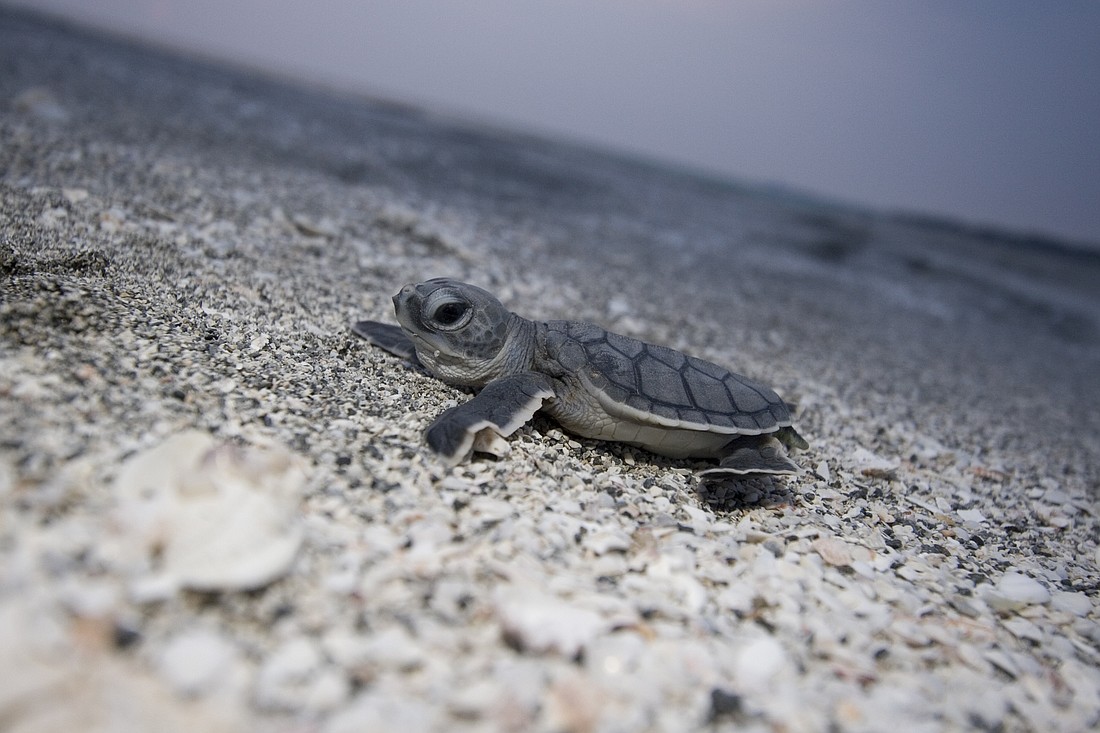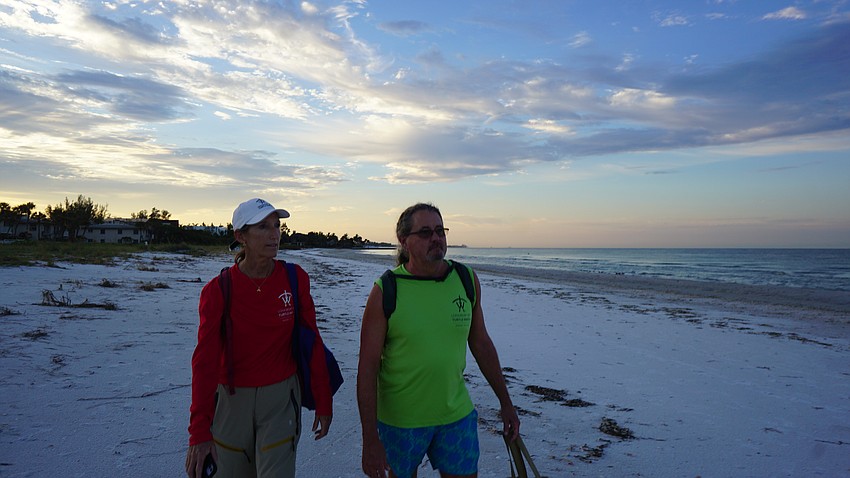- April 27, 2024
-
-
Loading

Loading

Minutes before 7 a.m., two members of Longboat Key Turtle Watch convene at the Broadway Street beach access point. It’s mid-September. Both Longboat Key Turtle Watch (LBKTW) and Mote Marine Laboratory are getting ready to wrap up the sea turtle nesting season. At this point in the season, only a couple volunteers patrol the beaches in the morning, spot checking the nests that have yet to hatch.
Cyndi Seamon is the vice president of LBKTW. Her companion this morning, and most other mornings, is Steve Howard. Seamon has been with LBKTW since 2004, and an officer since 2006. This is Howard’s fifth year with the group.
Howard says he’s often called “Sea Turtle Steve” by coworkers at his day job. The loggerhead sea turtle tattoo on his left shoulder covers up an old, faded eagle. A tattoo of the LBKTW logo adorns his opposite hip.
Along the short strip of beach that Seamon and Howard patrol is a nest that had to be relocated from Greer Island to be safe from the dredging project. Another nest has 165 eggs.
“That’s a huge nest,” Seamon says as she points to the front stake of the nest. The stakes mark the nest’s location and protect it from beach raking and beachgoers.
But the stakes also contain valuable information: turtle species, approximate location and, in some cases, number of eggs.
Two weeks prior, Hurricane Idalia brushed past Longboat Key, leaving behind heavy storm surge and flooding. The storm surge crept all the way up to the dunes, meaning the nests had to withstand a high degree of flooding. The turtles were pretty much done nesting by the time Idalia rolled around, Seamon says, but there were still nests on the island. After the flooding, LBKTW volunteers had to re-stake about 10 nests.
It’s not a sure thing the nests will hatch, but Seamon is staying optimistic.
In the 15-minute walk, Seamon and Howard find a few good shells and pick up a few pieces of trash, but no nests on their stretch of the beach showed signs of an emergence.
The two repeat this every morning for the rest of the season lasting until Oct. 31, or until all the documented nests are hatched.
As of this September, it was difficult for Mote’s Senior Biologist & Conservation Manager Melissa Macksey to definitively give seasonal trends.
But overall, it was a good year for sea turtles.
“We didn’t blow through the ceiling in numbers, but we had enough to keep us busy,” Macksey says. “We did have more green nests than we ever had before, and we had more nests on Venice than we’ve ever had before.”
One trend that Macksey noticed this year was the earlier beginning and end of the season. Sea turtles began nesting earlier in April this year. Some people believe that each year that nesting starts earlier means it’s going to be a strong year, but Macksey says this isn’t necessarily true.
Every species of sea turtle depends on temperature cues to know when nesting season is coming around. When the water gets warmer, then the turtles know it’s time to find a mate and begin laying eggs.
Over time, the beginning of nesting season has crept earlier and earlier as water temperatures get warmer earlier. Macksey says this season seemed to end earlier than normal, too. Activity began slowing down in the last weeks of July. The last nests were laid about two weeks before Hurricane Idalia, Macksey estimates. She says when the reports go two weeks without seeing any crawls, then they can call the nesting period finished.

Crawls can mean one of two things, both indicated by turtle tracks on the beach. If the tracks lead to a nest, then it’s recorded as such. But if the tracks lead back to the water without a nest, that’s called a false crawl. Due to warmer temperatures this summer, Macksey says there’s a possibility that there would be more female hatchlings.
The saying goes, “Hot chicks, cool dudes” — warmer incubation leads to females, while colder temperatures cause more males.
Macksey is also guessing that there will be a higher mortality rate this year. Some recorded temperatures near the nests were at fatal levels, she says.
But the total nest count was good overall, making this season the fourth highest since the program started in 1982.
As of September, the total nest count was 4,296. Last year was slightly higher, at 4,537, but this year topped 2021, which had 3,760.
This area of the world is particularly important for loggerhead sea turtles. According to Macksey, the southeast United States is home to the largest population of loggerheads. Of that population, 90% of the nesting happens in Florida. The second largest population is the population that nests in Oman from the Indian Ocean. And that population is declining, she says, whereas the U.S. population is increasing.
While the east coast of Florida gets more loggerhead activity, the Sarasota area has the highest density of nests on the Gulf Coast.
“It’s not the highest in Florida, but it’s still pretty important in the grand scheme of things,” Macksey says.
To manage the conservation of this important area, Mote has about six or seven staff on payroll for the turtle team. Macksey says the department has also taken on more summer interns throughout the years, who contribute greatly.
Aside from that, most of the “boots on the ground” work is done by a network of over 300 volunteers like Seamon and Howard with LBKTW.
“Considering that we share both the beach and the water with their home, we just need to be the best stewards of the environment that we can possibly be,” Seamon says.
The payoff of a successful nesting season is good. But what Seamon and Howard value just as much are the lifelong friendships both have built from volunteering with Longboat Key Turtle Watch.
And, of course, seeing a hatchling is a great day for them.